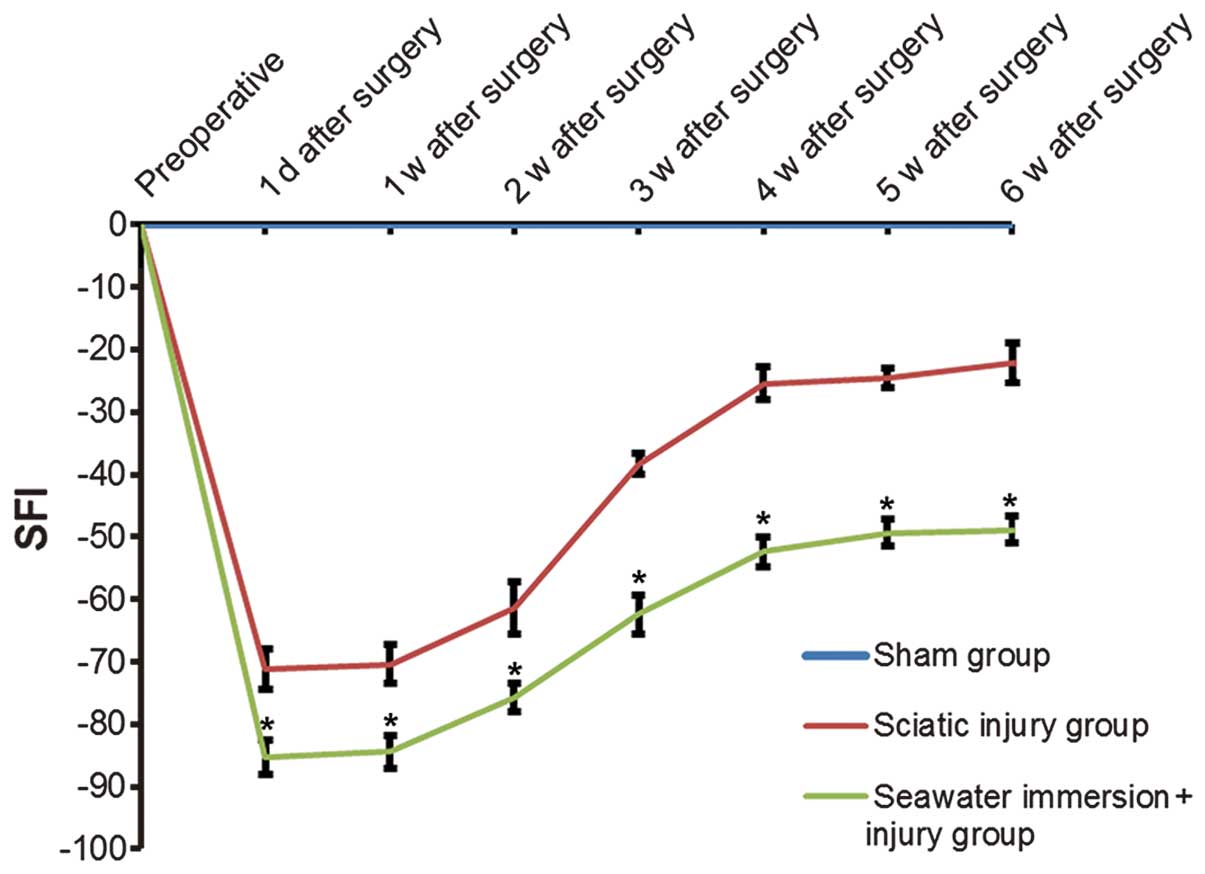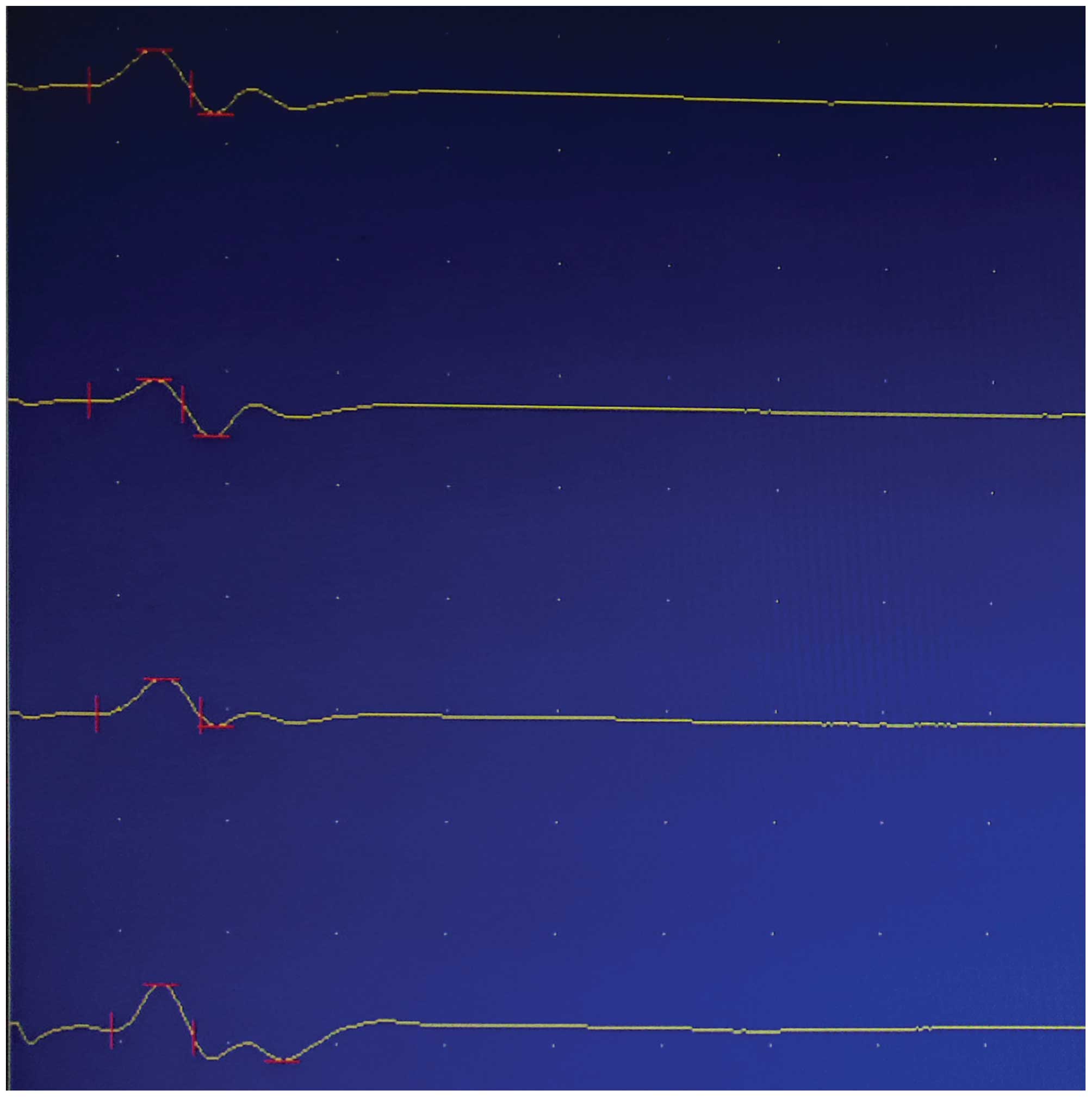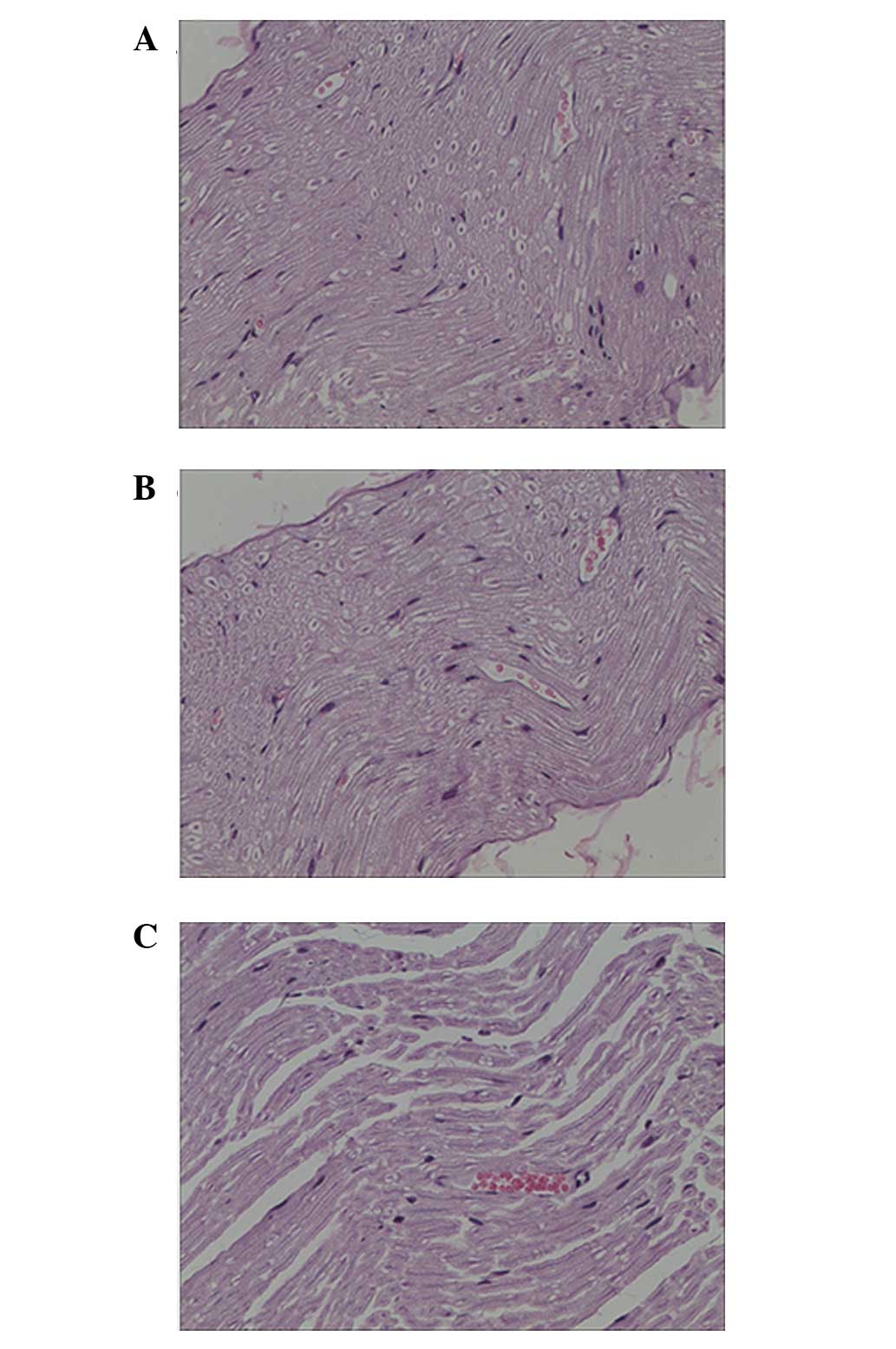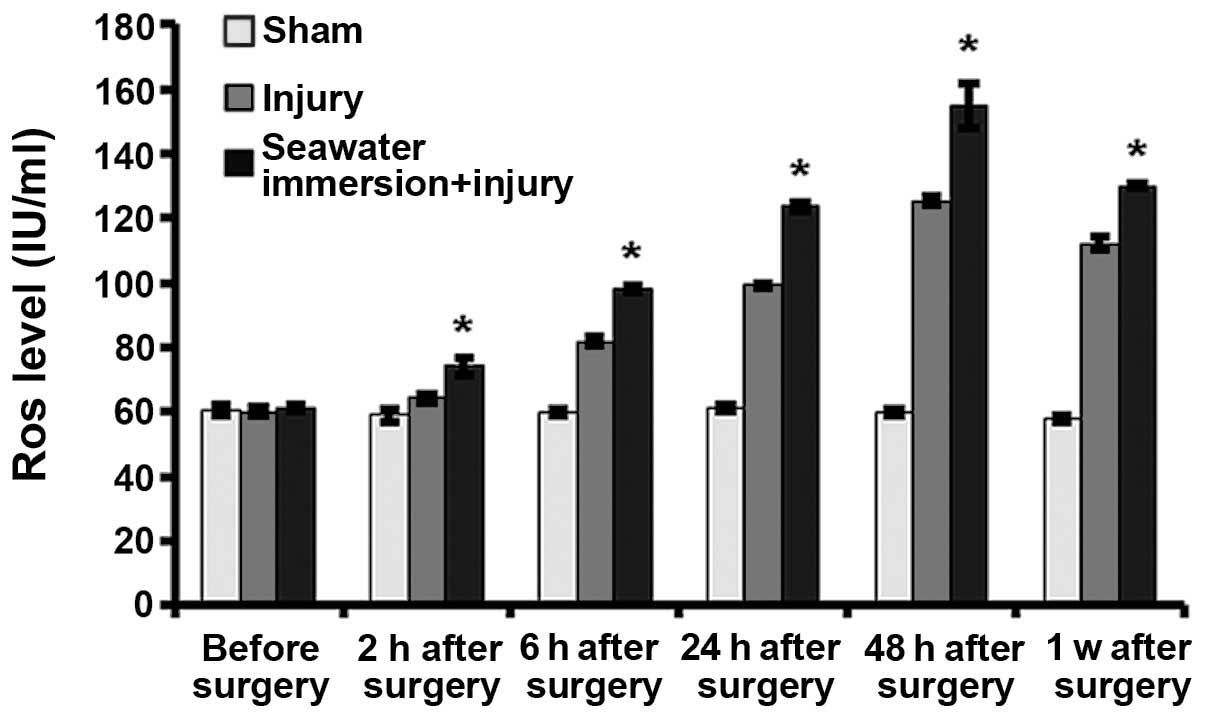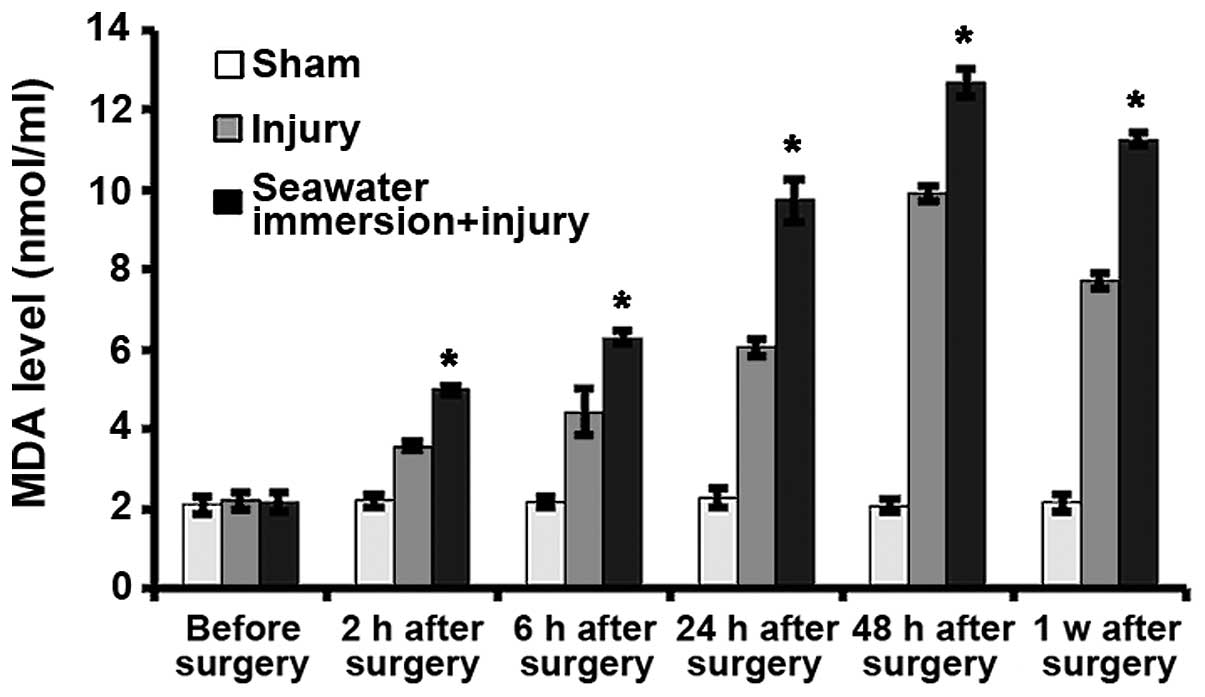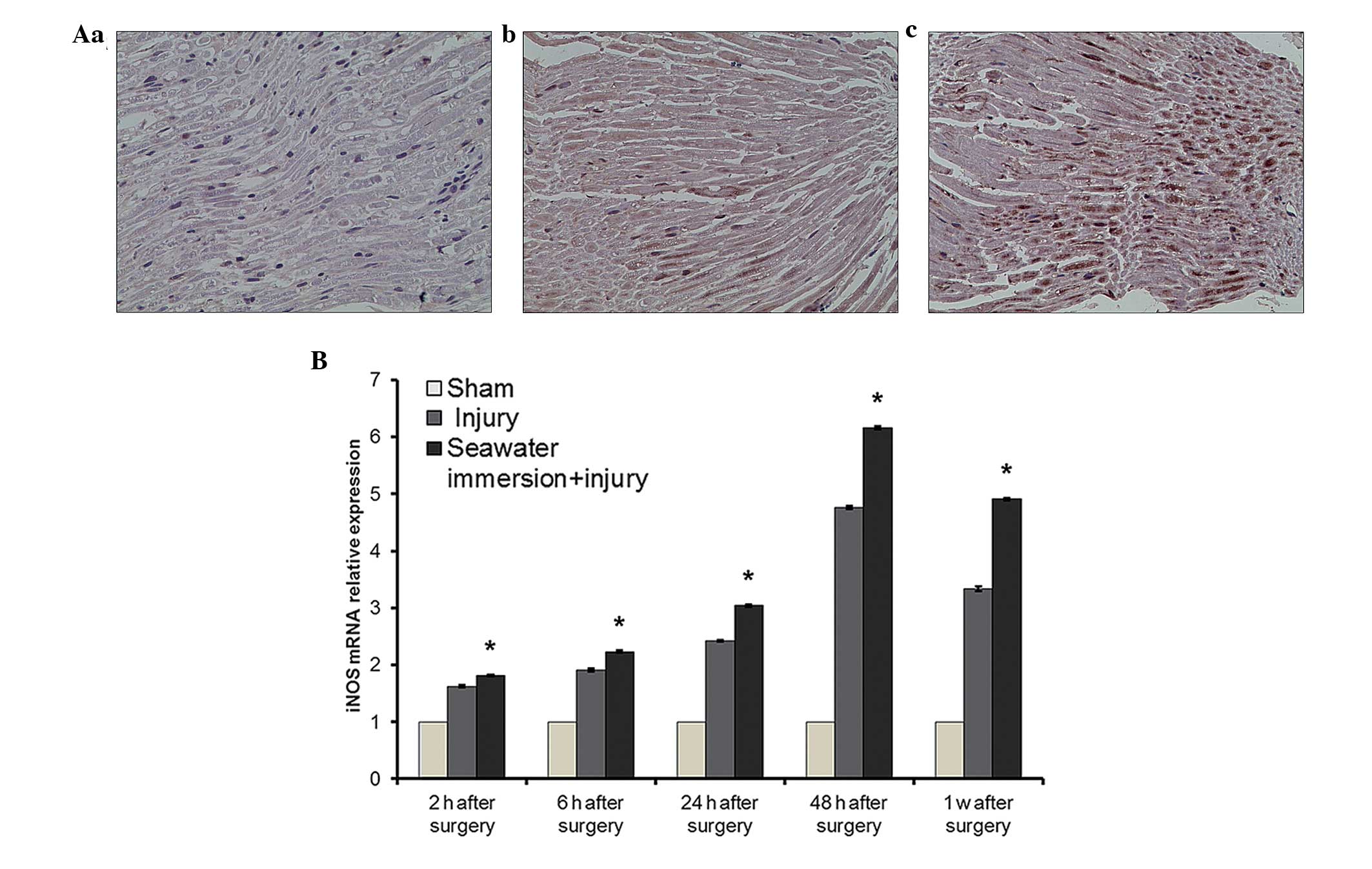|
1
|
Heumann R, Korsching S, Bandtlow C and
Thoenen H: Changes of nerve growth factor synthesis in nonneuronal
cells in response to sciatic nerve transection. J Cell Biol.
104:1623–1631. 1987. View Article : Google Scholar : PubMed/NCBI
|
|
2
|
Ress AM, Babovic S, Angel MF, Im MJ,
Dellon AL and Manson PN: Free radical damage in acute nerve
compression. Ann Plast Surg. 34:388–395. 1995. View Article : Google Scholar : PubMed/NCBI
|
|
3
|
Love A, Cotter MA and Cameron NE: Effects
of alpha-tocopherol on nerve conduction velocity and regeneration
following a freeze lesion in immature diabetic rats. Naunyn
Schmiedebergs Arch Pharmacol. 355:126–130. 1997. View Article : Google Scholar : PubMed/NCBI
|
|
4
|
Hervera A, Negrete R, Leánez S,
Martin-Campos JM and Pol O: The spinal cord expression of neuronal
and inducible nitric oxide synthases and their contribution in the
maintenance of neuropathic pain in mice. PLoS One. 5:e143212010.
View Article : Google Scholar : PubMed/NCBI
|
|
5
|
Lin H, Hou C and Chen D: Altered
expression of inducible nitric oxide synthase after sciatic nerve
injury in rat. Cell Biochem Biophys. 61:261–265. 2011. View Article : Google Scholar : PubMed/NCBI
|
|
6
|
Khalil Z and Khodr B: A role for free
radicals and nitric oxide in delayed recovery in aged rats with
chronic constriction nerve injury. Free Radic Biol Med. 31:430–439.
2001. View Article : Google Scholar : PubMed/NCBI
|
|
7
|
Naik AK, Tandan SK, Dudhgaonkar SP, et al:
Role of oxidative stress in pathophysiology of peripheral
neuropathy and modulation by N-acetyl-L-cysteine in rats. Eur J
Pain. 10:573–579. 2006. View Article : Google Scholar
|
|
8
|
Tariq M, Arshaduddin M, Biary N, Al Deeb S
and Al Moutaery K: Diethyldithiocarbamate (DEDC) impairs neuronal
recovery following sciatic nerve injury in rats. Restor Neurol
Neurosci. 17:135–141. 2000.PubMed/NCBI
|
|
9
|
Haddad V Jr, Lupi O, Lonza JP and Tyring
SK: Tropical dermatology: Marine and aquatic dermatology. J Am Acad
Dermatol. 61:733–750. 2009. View Article : Google Scholar : PubMed/NCBI
|
|
10
|
Gregorakos L, Markou N, Psalida V, et al:
Near-drowning: clinical course of lung injury in adults. Lung.
187:93–97. 2009. View Article : Google Scholar : PubMed/NCBI
|
|
11
|
Tobias SW, Matthew CB, Dubose DA and
Hamlet MP: Comparison of oxygenated perfluorocarbon and humidified
oxygen for rewarming hypothermic miniswine. Mil Med. 166:853–861.
2001.PubMed/NCBI
|
|
12
|
Rui M, Duan YY, Zhang XH, Wang HL and Wang
DP: Urinary trypsin inhibitor attenuates seawater-induced acute
lung injury by influencing the activities of nuclear factor-κB and
its related inflammatory mediators. Respiration. 83:335–343. 2012.
View Article : Google Scholar
|
|
13
|
Fan ZF, Wang JH, Li ZQ and Yi CH:
Influence of sea water immersion on inflammation and healing of the
wounds in scalded rats. Zhonghua Shao Shang Za Zhi. 22:215–217.
2006.(In Chinese). PubMed/NCBI
|
|
14
|
Hu XH, Duan YY, Li Y and Xue ZQ: Early
responses of VEGF during acute lung injury induced by seawater
immersion after open chest trauma. Respiration. 79:490–496. 2010.
View Article : Google Scholar
|
|
15
|
Pan MH, Jiang SJ, Liu XH, et al: Topical
dorsal skin immersion in seawater induces apoptosis and
proliferation in hairless mice. J Dermatol. 34:683–690. 2007.
View Article : Google Scholar : PubMed/NCBI
|
|
16
|
Chen L, Lai X, Chen Z and Zhang L: The
influence of seawater on lipid peroxidation of the muscle tissue
wounded by firearm in rabbit limbs. Zhongguo Bing Li Sheng Li Za
Zhi. 17:556–558. 2001.(In Chinese).
|
|
17
|
Liu P, Liu JC, Lai XN, et al: Pathological
study of rabbits’ femoral arteries subjected to gunshot wounds
combining with seawater immersion. Chin J Traumatol. 8:186–190.
2005.PubMed/NCBI
|
|
18
|
Lai X, Wang L and Chen L: Nitric oxide
level in firearm wounded skeletal muscle of rabbits extremities
after seawater immersion and its significance. Chuang Shang Wai Ke
Za Zhi. 1:26–28. 1999.(In Chinese).
|
|
19
|
Brown TJ, Khan T and Jones KJ: Androgen
induced acceleration of functional recovery after rat sciatic nerve
injury. Restor Neurol Neurosci. 15:289–295. 1999.
|
|
20
|
Kaya Y, Sarikcioğlu L, Aslan M, et al:
Comparison of the beneficial effect of melatonin on recovery after
cut and crush sciatic nerve injury: a combined study using
functional, electrophysiological, biochemical and electron
microscopic analyses. Childs Nerv Syst. 29:389–401. 2013.
View Article : Google Scholar
|
|
21
|
Iannacone JM, Ren S, Hatcher NG and
Sweedler JV: Collecting peptide release from the brain using porous
polymer monolith-based solid phase extraction capillaries. Anal
Chem. 81:5433–5438. 2009. View Article : Google Scholar : PubMed/NCBI
|
|
22
|
Pan HC, Wu HT, Cheng FC, Chen CH, Sheu ML
and Chen CJ: Potentiation of angiogenesis and regeneration by G-CSF
after sciatic nerve crush injury. Biochem Biophys Res Commun.
382:177–182. 2009. View Article : Google Scholar : PubMed/NCBI
|
|
23
|
Jiang M, Zhuge X, Yang Y, Gu X and Ding F:
The promotion of peripheral nerve regeneration by
chitooligosaccharides in the rat nerve crush injury model. Neurosci
Lett. 454:239–243. 2009. View Article : Google Scholar : PubMed/NCBI
|
|
24
|
Gong Y, Gong L, Gu X and Ding F:
Chitooligosaccharides promote peripheral nerve regeneration in a
rabbit common peroneal nerve crush injury model. Microsurgery.
29:650–656. 2009. View Article : Google Scholar : PubMed/NCBI
|
|
25
|
Schiaveto de Souza A, da Silva CA and Del
Bel EA: Methodological evaluation to analyze functional recovery
after sciatic nerve injury. J Neurotrauma. 21:627–635. 2004.
View Article : Google Scholar : PubMed/NCBI
|
|
26
|
Tariq M, Arshaduddin M, Biary N, Al Deep S
and Al Moutaery K: Effect of aminoguanidine, a nitric oxide
synthase inhibitor on sciatic nerve crush injury in rats. Med Sci
Res. 25:815–818. 1997.
|
|
27
|
Yang Y, Ding F, Wu J, et al: Development
and evaluation of silk fibroin-based nerve grafts used for
peripheral nerve regeneration. Biomaterials. 28:5526–5535. 2007.
View Article : Google Scholar : PubMed/NCBI
|
|
28
|
Yang Y, Ding F, Wu J, et al: Development
and evaluation of silk fibroin-based nerve grafts used for
peripheral nerve regeneration. Biomaterials. 28:5526–5535. 2007.
View Article : Google Scholar : PubMed/NCBI
|
|
29
|
Dubovy P: Wallerian degeneration and
peripheral nerve conditions for both axonal regeneration and
neuropathic pain induction. Ann Anat. 193:267–275. 2011. View Article : Google Scholar : PubMed/NCBI
|
|
30
|
Gu X, Ding F, Yang Y and Liu J:
Construction of tissue engineered nerve grafts and their
application in peripheral nerve regeneration. Prog Neurobiol.
93:204–230. 2011. View Article : Google Scholar
|
|
31
|
Shapiro L and Dinarello CA: Hyperosmotic
stress as a stimulant for proinflammatory cytokine production. Exp
Cell Res. 231:354–362. 1997. View Article : Google Scholar : PubMed/NCBI
|
|
32
|
Yan H, Ge HJ, Lai XN and Liu HQ: Effect of
seawater immersion on hemostatic function after burn in dog.
Zhonghua Ma Zui Xue Za Zhi. 24:688–770. 2004.(In Chinese).
|
|
33
|
Luo ZA, Pu T and Huang Q: Treatment
analysis of calf injury from the final hypertrophic alkaline
seawater. Zhongguo Jiao Xing Wai Ke Za Zhi. 5:4671998.(In
Chinese).
|
|
34
|
Wei X and Hou SS: The characteristics and
treatment principle of seawater immersion firearm injury. Jie Fang
Jun Yu Fang Yi Xue Za Zhi. 21:76–78. 2003.(In Chinese).
|
|
35
|
Tikuisis P: Prediction of survival time at
sea based on observed body cooling rates. Aviat Space Environ Med.
68:441–448. 1997.PubMed/NCBI
|
|
36
|
Atik B, Erkutlu I, Tercan M,
Buyukhatipoglu H, Bekerecioglu M and Pence S: The effects of
exogenous melatonin on peripheral nerve regeneration and collagen
formation in rats. J Surg Res. 166:330–336. 2011. View Article : Google Scholar
|
|
37
|
Sayan H, Ozacmak VH, Ozen OA, et al:
Beneficial effects of melatonin on reperfusion injury in rat
sciatic nerve. J Pineal Res. 37:143–148. 2004. View Article : Google Scholar : PubMed/NCBI
|
|
38
|
Liao W, Yang W and Tian J: Experimental
study on the effects of free peroxidation of neurolipid following
crushing injury of peripheral nerve. Zhongguo Xiu Fu Chong Jian Wai
Ke Za Zhi. 10:20–22. 1996.(In Chinese).
|
|
39
|
Baldus S, Rudolph V, Roiss M, et al:
Heparins increase endothelial nitric oxide bioavailability by
liberating vessel-immobilized myeloperoxidase. Circulation.
113:1871–1878. 2006. View Article : Google Scholar : PubMed/NCBI
|
|
40
|
Shin SJ, Qi WN, Cai YT, et al: Inhibition
of inducible nitric oxide synthase promotes recovery of motor
function in rats after sciatic nerve ischemia and reperfusion. J
Hand Surg Am. 30:826–835. 2005. View Article : Google Scholar : PubMed/NCBI
|















